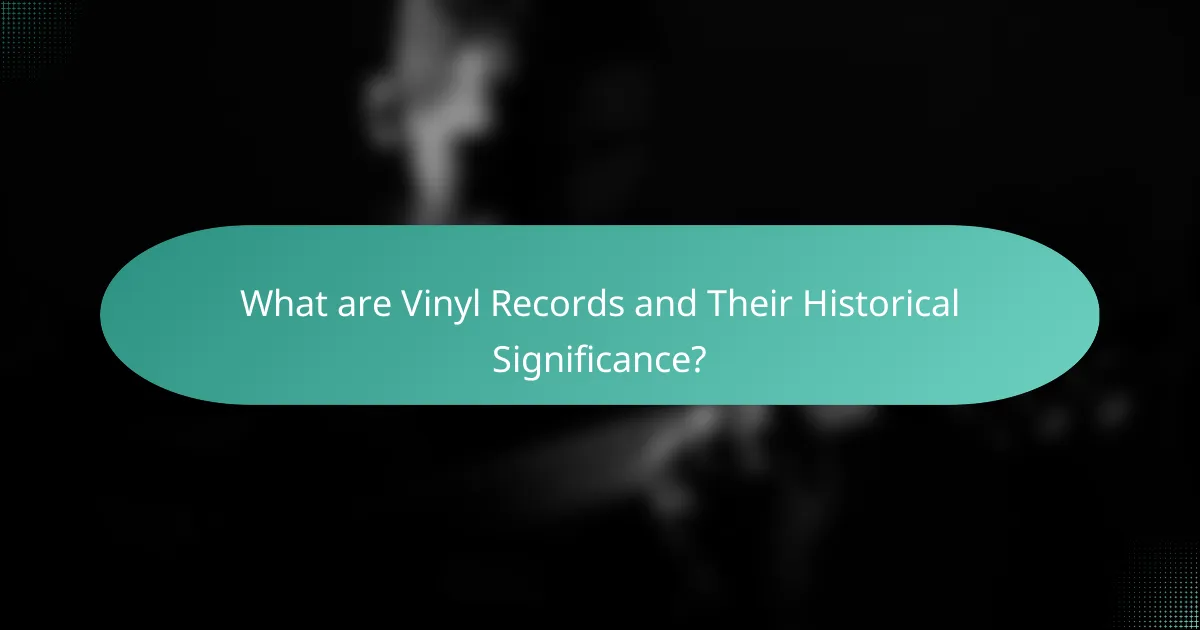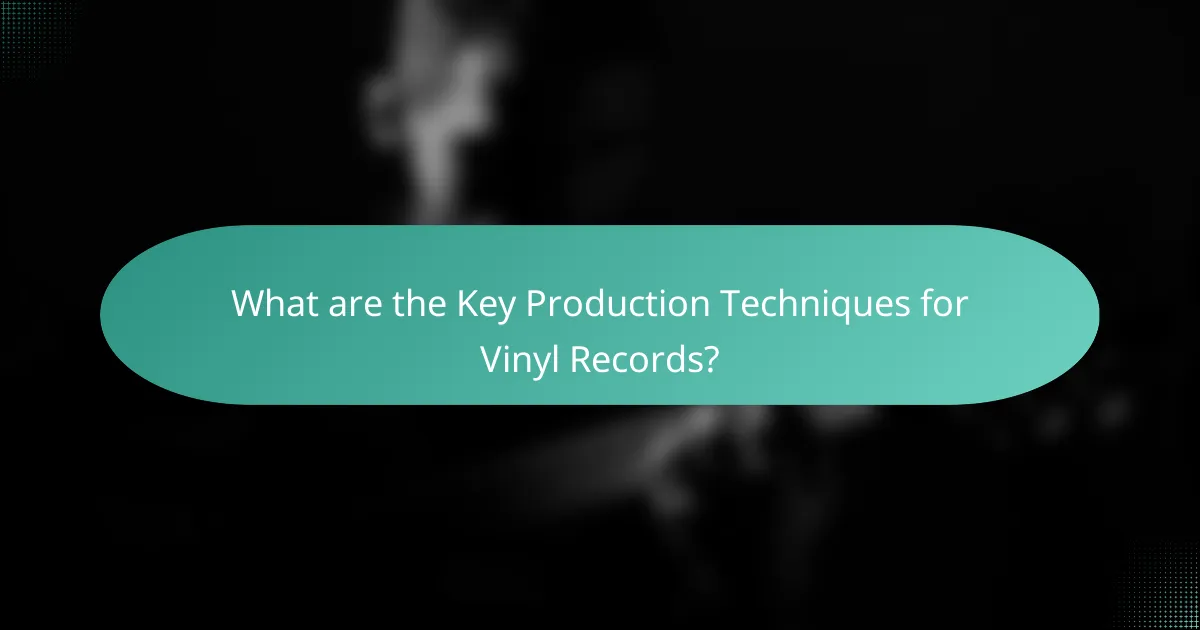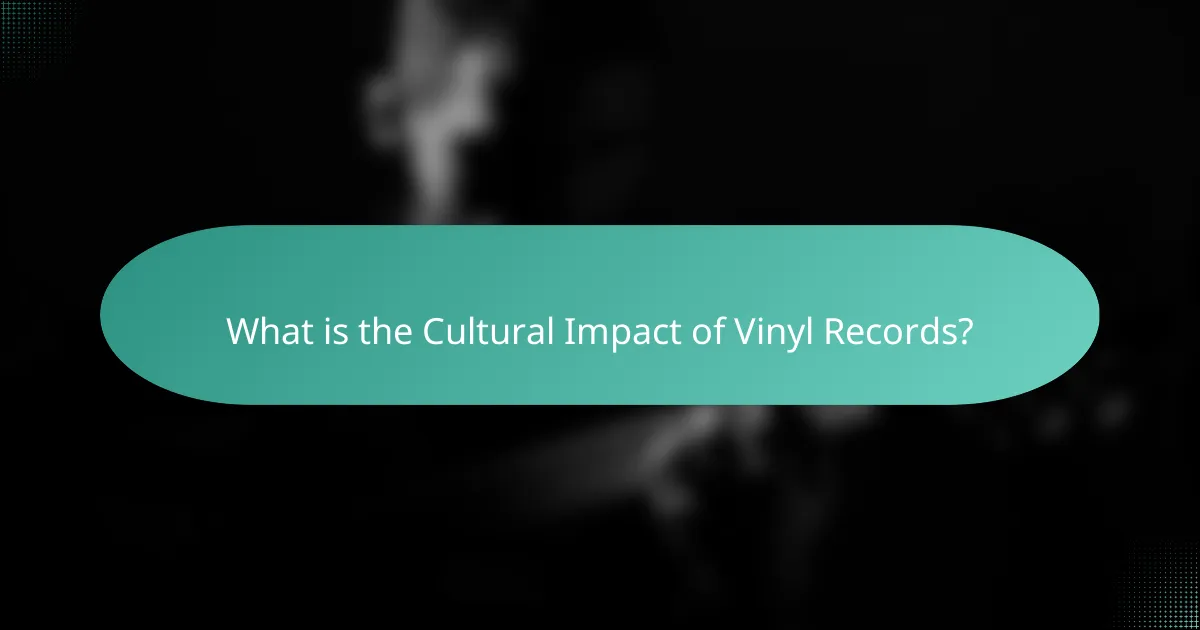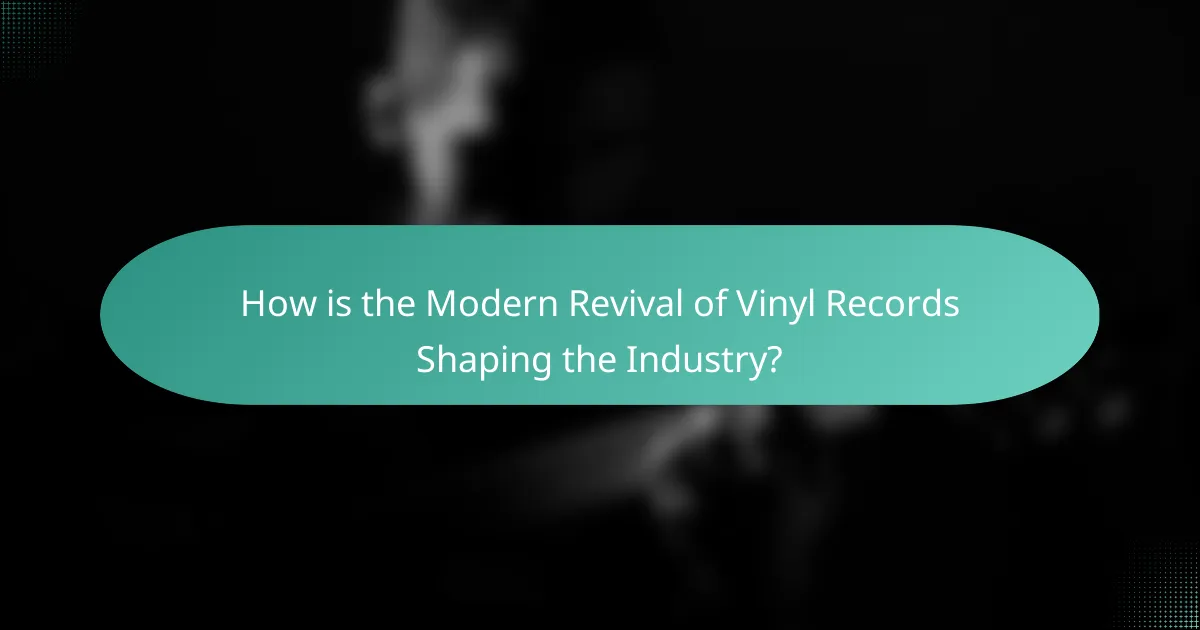Vinyl records are analog sound storage mediums made from polyvinyl chloride, first introduced in the late 1940s, which replaced shellac records. This article explores the evolution of vinyl records, focusing on key production techniques such as mastering, cutting, and pressing, which enhance sound fidelity and durability. It also examines the cultural impact of vinyl records, highlighting their role in popularizing album-oriented music and fostering a deeper connection to music. The recent resurgence in vinyl sales, surpassing CD sales in 2020, reflects a cultural shift towards nostalgia and authenticity, influencing consumer behavior and promoting diversity in the music industry.

What are Vinyl Records and Their Historical Significance?
Vinyl records are analog sound storage mediums made from polyvinyl chloride. They were first introduced in the late 1940s, replacing shellac records. Vinyl records played a crucial role in the music industry for decades. They allowed for longer playback times and better sound quality. The 33 1/3 RPM long-playing (LP) format became standard in 1948. This format enabled the recording of multiple tracks on a single disc. Vinyl records became a symbol of music culture and personal expression in the 1960s and 1970s. Their significance is evident in the resurgence of vinyl sales in recent years, surpassing CD sales in 2020 for the first time since the 1980s. This revival highlights their lasting impact on music consumption and nostalgia.
How did vinyl records originate and evolve over time?
Vinyl records originated in the late 19th century as an evolution of earlier sound recording methods. The first practical sound recording medium was the phonograph cylinder, invented by Thomas Edison in 1877. By the early 1900s, flat discs made from shellac began to replace cylinders. These shellac records were heavy and brittle, typically holding about three minutes of audio per side.
In the 1930s, vinyl began to be used as a material for records. Vinyl records offered greater durability and sound quality compared to shellac. The introduction of the 33 1/3 RPM long-playing (LP) record in 1948 by Columbia Records marked a significant advancement. This allowed for longer playback times, accommodating multiple tracks on one disc.
The 45 RPM single, introduced by RCA Victor in 1949, became the standard for popular music. The 1950s and 1960s saw vinyl records become the dominant format for music consumption. They were widely used in homes and radio stations, shaping music culture.
By the 1980s, vinyl records faced competition from cassette tapes and later CDs, leading to a decline in popularity. However, the 2000s saw a resurgence in vinyl’s popularity. Collectors and audiophiles began to appreciate the analog sound quality and tactile experience of vinyl.
Today, vinyl records are celebrated for their nostalgic value and unique sound. They have become a symbol of music culture and artistry. The revival of vinyl has led to new production techniques and a thriving market for both new releases and reissues of classic albums.
What materials were initially used in the production of vinyl records?
The initial materials used in the production of vinyl records were polyvinyl chloride (PVC) and a mixture of various additives. PVC served as the primary substance for its durability and flexibility. Additionally, other materials included dyes for coloring and stabilizers to enhance the record’s longevity. The use of PVC began in the late 1940s, replacing shellac, which was the standard material before vinyl. This shift allowed for better sound quality and more intricate grooves. The transition was significant in the music industry, as vinyl records became the dominant format for music distribution.
How did technological advancements influence vinyl record production?
Technological advancements significantly influenced vinyl record production by enhancing manufacturing precision and efficiency. Innovations in cutting technology improved groove design, resulting in better sound quality. The introduction of digital mastering techniques allowed for more intricate audio manipulation. Automation in pressing plants increased production speed and consistency. Advancements in materials, such as high-quality PVC, improved durability and reduced surface noise. Additionally, computer-aided design enabled precise control over the vinyl’s physical attributes. These changes collectively elevated the listening experience and expanded vinyl’s appeal in the music industry.
What role did vinyl records play in the music industry?
Vinyl records served as a primary medium for music distribution from the late 19th century until the 1980s. They enabled artists to reach wider audiences through physical sales. The introduction of the 33 1/3 RPM LP format in 1948 allowed for longer recordings. This innovation transformed album releases and encouraged artistic experimentation. Vinyl records also fostered a unique listening experience with their analog sound quality. The physical format created a tangible connection between artists and fans. Additionally, vinyl records became cultural artifacts, influencing fashion and lifestyle. Their resurgence in recent years highlights their enduring appeal in the music industry.
How did vinyl records shape the distribution of music?
Vinyl records revolutionized the distribution of music by enabling mass production and widespread availability. They allowed artists to reach larger audiences through record labels. The introduction of the 33 1/3 RPM long-playing record in 1948 facilitated full album releases. This format encouraged artists to create cohesive bodies of work rather than just singles. Vinyl records also established a standard for audio quality that was superior to previous formats. In the 1960s, vinyl became the primary medium for music consumption, influencing radio play and sales strategies. The physical nature of vinyl records fostered a culture of collecting and sharing music. This shaped the music industry’s marketing and distribution practices for decades.
What impact did vinyl records have on music genres and artists?
Vinyl records significantly shaped music genres and artists by providing a medium for high-quality sound. Their introduction in the early 20th century allowed for longer playtime compared to earlier formats. This capacity enabled the development of full-length albums, influencing genres like rock, jazz, and classical. Artists could now express their creativity over extended durations. The tactile nature of vinyl also fostered a strong connection between artists and fans. Record covers became a canvas for visual art, enhancing the overall experience. Additionally, vinyl’s resurgence has led to a renewed interest in analog sound among contemporary musicians. This revival has influenced new genres and styles, bridging past and present musical trends.

What are the Key Production Techniques for Vinyl Records?
Key production techniques for vinyl records include mastering, cutting, and pressing. Mastering involves preparing the audio for vinyl by optimizing sound quality. This process ensures the final product has the desired tonal balance and dynamic range. Cutting refers to transferring the mastered audio onto a lacquer disc. A lathe carves grooves into the lacquer, creating a negative impression of the sound. Pressing is the final step where the lacquer master is used to create vinyl records. During pressing, heated vinyl pellets are molded into discs with grooves that reproduce the audio. These techniques have been refined since the first vinyl records emerged in the late 1940s, enhancing sound fidelity and durability. The quality of each step directly impacts the listening experience, making these techniques crucial in vinyl production.
How is a vinyl record produced from start to finish?
Vinyl records are produced through a detailed process involving several key steps. First, the audio is recorded and mixed in a studio. This creates a master recording that serves as the source for the vinyl. Next, the master recording is cut onto a lacquer disc using a cutting lathe. This process involves creating grooves that represent the audio waveform.
After cutting, the lacquer disc is sent for electroplating. During electroplating, a metal master is created by coating the lacquer with a layer of metal. This metal master is then used to create a stamp, known as a mother. The mother can produce multiple stampers, which are necessary for mass production.
In the next step, raw vinyl pellets are heated and pressed into discs using the stampers. This process shapes the vinyl into the final record form. The records are then cooled and trimmed to ensure they meet quality standards. Finally, the finished vinyl records are packaged and distributed for sale.
This production method allows for high-quality sound reproduction and has been refined over decades, contributing to the resurgence of vinyl in modern music culture.
What are the steps involved in mastering a vinyl record?
The steps involved in mastering a vinyl record include preparing the audio, equalization, compression, and creating the master. First, audio preparation involves cleaning up the tracks and ensuring they are free of unwanted noise. Next, equalization adjusts the tonal balance of the audio to enhance clarity and presence. Compression is applied to control the dynamic range, ensuring consistent volume levels. The final step is creating the master, which involves transferring the audio to a lacquer or digital file for pressing. Each step is crucial for achieving high-quality sound on vinyl.
How does the pressing process work for vinyl records?
The pressing process for vinyl records involves several key steps. First, a master recording is created, typically from a digital or analog source. This master is then used to produce a metal stamper. The stamper is made from a lacquer disc coated with a thin layer of metal.
Next, vinyl pellets are heated and formed into a puck. This puck is placed between two stampers in a hydraulic press. The press applies heat and pressure, which molds the vinyl into the final shape of the record.
After pressing, the records are cooled and trimmed to remove excess vinyl. The final step involves quality control to ensure sound quality and physical integrity. This process is crucial for producing high-fidelity audio playback, which is a hallmark of vinyl records.
What innovations have emerged in vinyl record production?
Innovations in vinyl record production include digital cutting technology and improved materials. Digital cutting allows for greater precision in grooves, enhancing sound quality. Advanced vinyl formulations reduce surface noise and improve durability. Eco-friendly production methods are now being adopted, minimizing environmental impact. Innovations also include color vinyl and custom designs, appealing to collectors. Automated pressing machines increase efficiency and reduce production time. These advancements reflect a blend of tradition and modern technology in vinyl manufacturing.
How has digital technology impacted vinyl record manufacturing?
Digital technology has significantly transformed vinyl record manufacturing. It has introduced precision in audio mastering and cutting processes. Digital audio files allow for higher fidelity and clearer sound reproduction. Additionally, computer-assisted design tools enhance the artwork and packaging of vinyl records. Automation in manufacturing has increased production efficiency and reduced costs. Digital technology also facilitates the distribution of vinyl records through online platforms. This shift has revitalized interest in vinyl, leading to a resurgence in sales. In 2020, vinyl sales in the U.S. surpassed CD sales for the first time since the 1980s, highlighting this impact.
What are the benefits of using analog techniques in production?
Analog techniques in production offer several benefits. They provide a warmer sound quality, which many listeners prefer. Analog recordings capture nuances in audio that digital formats may miss. This results in a richer listening experience. Additionally, analog techniques often encourage a more hands-on approach to music creation. This can foster creativity and artistic expression. Many artists appreciate the tangible nature of analog equipment. Studies show that analog recordings can evoke stronger emotional responses in listeners. This emotional connection enhances the overall impact of the music.

What is the Cultural Impact of Vinyl Records?
Vinyl records have significantly influenced music culture and consumer behavior. They popularized album-oriented music and the concept of the “album” as an art form. The tactile experience of handling records fosters a deeper connection to music. Vinyl’s resurgence has sparked a revival in analog sound appreciation. According to the Recording Industry Association of America, vinyl sales reached a 30-year high in 2020, surpassing CD sales for the first time since the 1980s. This trend reflects a cultural shift towards nostalgia and authenticity in music consumption. Vinyl records also support independent artists and labels, promoting diversity in the music industry. Collecting vinyl has become a cultural phenomenon, fostering community among enthusiasts.
How have vinyl records influenced music culture and communities?
Vinyl records have significantly influenced music culture and communities by shaping listening habits and fostering a sense of connection. They provide a tangible medium for music, enhancing the experience of album artwork and liner notes. Vinyl’s resurgence has led to a revival of record stores, creating community hubs for music enthusiasts. Events like record fairs and listening parties have strengthened social bonds among fans. The physicality of vinyl encourages collectors to engage deeply with their music. Statistics show that vinyl sales have surged, with over 41 million units sold in the U.S. in 2020, marking the highest sales since 1986. This growth reflects a cultural shift towards appreciating analog formats in a digital age. Vinyl records have also inspired a renewed interest in music genres, leading to the rediscovery of classic artists and new talent alike.
What role do vinyl records play in collector culture?
Vinyl records are central to collector culture as they represent a tangible connection to music history. Collectors often seek rare pressings and limited editions, which can significantly increase in value. The tactile experience of handling vinyl appeals to many enthusiasts. Vinyl also fosters a sense of community among collectors. Events like record fairs and swap meets allow collectors to share their passion. Additionally, the resurgence of vinyl sales, which reached 41 million units in 2020, highlights its enduring appeal. Collectors often appreciate the unique sound quality of vinyl compared to digital formats. The artwork and packaging of vinyl records also enhance their collectible nature.
How have vinyl records contributed to nostalgia in music consumption?
Vinyl records have significantly contributed to nostalgia in music consumption by evoking memories of past experiences. The tactile nature of vinyl, including the large album covers and the act of placing a record on a turntable, creates a physical connection to music. This experience contrasts sharply with digital formats, which often lack a tangible element.
Research indicates that listening to vinyl can trigger emotional responses, enhancing the nostalgic experience. According to a study by the University of Southern California, nostalgia is often linked to music, with vinyl records being a prominent medium associated with personal memories.
The revival of vinyl sales, which reached 41 million units in 2020 in the United States alone, underscores this trend. Many consumers seek vinyl records to reconnect with the music of their youth. This resurgence reflects a broader cultural appreciation for retro aesthetics and analog sound quality.
What are the social implications of vinyl records in contemporary society?
Vinyl records have significant social implications in contemporary society. They symbolize nostalgia and a return to analog experiences. Many people associate vinyl with authenticity and a deeper connection to music. The resurgence of vinyl sales, which reached over 41 million units in 2020, illustrates this trend. This revival fosters community among collectors and enthusiasts. Vinyl records often serve as a medium for artistic expression through album artwork. They also encourage local music scenes by supporting independent artists and labels. The tactile nature of vinyl promotes a more engaged listening experience compared to digital formats. Overall, vinyl records contribute to a cultural movement that values craftsmanship and personal connection in music consumption.
How do vinyl records foster connections among music enthusiasts?
Vinyl records foster connections among music enthusiasts through shared experiences and communal activities. The tactile nature of handling records encourages listening parties and social gatherings. These events allow fans to discuss their favorite albums and artists in depth. Additionally, record stores often serve as community hubs for music lovers. They host events like live performances and listening sessions. This creates an environment for networking and building friendships. Furthermore, the nostalgia associated with vinyl attracts collectors who share their finds online. Online platforms and forums facilitate discussions about music, pressing techniques, and rare editions. Collectors often bond over their passion for vinyl, strengthening community ties.
What movements or trends have emerged around vinyl records?
The resurgence of vinyl records has led to several notable movements and trends. One significant trend is the revival of analog audio, emphasizing sound quality and warmth. Many audiophiles prefer vinyl for its richer sound compared to digital formats. Another movement is the growth of independent record stores, which have become cultural hubs for music enthusiasts. These stores often host events, fostering community engagement. The rise of vinyl subscription services has also emerged, offering curated selections to collectors. In 2020, vinyl sales surpassed CD sales in the U.S. for the first time since the 1980s, highlighting its renewed popularity. Additionally, artists are increasingly releasing albums exclusively on vinyl, catering to dedicated fans. This trend reflects a broader appreciation for physical media in a digital age.

How is the Modern Revival of Vinyl Records Shaping the Industry?
The modern revival of vinyl records is significantly reshaping the music industry. Vinyl sales have surged, reaching over 41 million units sold in the U.S. in 2020, surpassing CD sales for the first time since the 1980s. This resurgence has led to a renewed interest in analog sound quality and the physicality of music. Labels are investing more in vinyl production, resulting in increased manufacturing capacity and innovation in pressing techniques. Artists are also releasing exclusive vinyl editions to cater to collectors and fans. This trend has fostered a vibrant community around record shops and vinyl events. The revival has influenced streaming services to offer curated vinyl playlists and merchandise. Overall, the modern revival of vinyl records is driving both economic growth and cultural appreciation within the industry.
What factors are driving the resurgence of vinyl records today?
The resurgence of vinyl records today is driven by a combination of nostalgia, sound quality, and collectible value. Nostalgia plays a significant role as many consumers seek a tangible connection to music from their past. This emotional attachment is particularly strong among those who grew up with vinyl. Sound quality is another factor; vinyl records are often perceived to offer a richer, warmer sound compared to digital formats. Collectibility also drives interest; limited editions and unique pressings attract collectors and enthusiasts. According to the Recording Industry Association of America, vinyl sales reached 38 million units in 2020, the highest number since 1986. This statistic underscores the growing demand and cultural significance of vinyl in the modern music landscape.
How has the rise of streaming affected vinyl record sales?
The rise of streaming has positively affected vinyl record sales. Streaming services increased music accessibility, leading to renewed interest in physical formats. Many consumers now seek tangible music experiences. This trend has contributed to a significant resurgence in vinyl sales. In 2020, vinyl sales in the U.S. surpassed CD sales for the first time since the 1980s. According to the Recording Industry Association of America (RIAA), vinyl revenue reached $619 million in 2020. This indicates a strong market demand for vinyl records, despite the prevalence of streaming. The nostalgic appeal of vinyl and its unique sound quality also play a role in this revival.
What demographic is most engaged in the modern vinyl revival?
The demographic most engaged in the modern vinyl revival is primarily young adults aged 18 to 34. This age group shows a significant interest in vinyl records for their tangible quality and nostalgic value. According to a 2022 report by the Recording Industry Association of America (RIAA), 41% of vinyl sales come from this demographic. Additionally, millennials and Gen Z consumers appreciate the aesthetic and tactile experience of vinyl. This trend is supported by the rise of vinyl sales, which have consistently increased over the past decade, reaching over 38 million units sold in 2021. These statistics highlight the strong engagement of younger audiences in the vinyl revival.
What are the best practices for collecting and maintaining vinyl records?
The best practices for collecting and maintaining vinyl records include proper storage, handling, and cleaning. Store records vertically to prevent warping. Use protective sleeves to shield from dust and scratches. Handle records by the edges to avoid fingerprints. Clean records regularly with a carbon fiber brush or a record cleaning solution. Avoid exposing records to extreme temperatures and humidity. Keep records away from direct sunlight to prevent fading. Use a quality turntable and stylus for optimal playback. Regular maintenance enhances the longevity and sound quality of vinyl records.
How can collectors ensure the longevity of their vinyl records?
Collectors can ensure the longevity of their vinyl records by following proper care and storage practices. Store records vertically to prevent warping. Keep them in a controlled environment with stable temperature and humidity. Avoid exposure to direct sunlight, which can damage the vinyl. Clean records regularly using a carbon fiber brush or a dedicated record cleaning solution. Handle records by the edges to minimize fingerprints and oils. Use high-quality inner and outer sleeves to protect from dust and scratches. These practices help maintain sound quality and prevent deterioration. Research shows that proper storage can extend the life of vinyl records significantly.
What tips are there for new collectors entering the vinyl market?
Start by researching different genres and artists. This helps you identify what you enjoy. Focus on quality over quantity. Investing in well-pressed records enhances your listening experience. Check for condition ratings like Mint or Near Mint. This ensures you buy records in good shape. Use a reputable dealer or established online platforms. This reduces the risk of purchasing counterfeits. Join local or online vinyl communities. Networking with other collectors can provide valuable insights. Attend record fairs and shops. These events often have unique finds and knowledgeable sellers. Lastly, be patient and enjoy the process. Building a collection takes time and effort.
The main entity of this article is vinyl records, which are analog sound storage mediums that have played a significant role in the music industry since their introduction in the late 1940s. The article explores the historical significance of vinyl records, detailing their evolution from early sound recording methods to their dominance in music consumption. It highlights key production techniques, the cultural impact of vinyl on music communities, and the modern revival that has seen vinyl surpass CD sales for the first time since the 1980s. Additionally, it discusses the factors driving this resurgence, including nostalgia, sound quality, and the role of digital technology in manufacturing.